#yet every character we meet has the express goal of trying to optimize killing themselves
Text

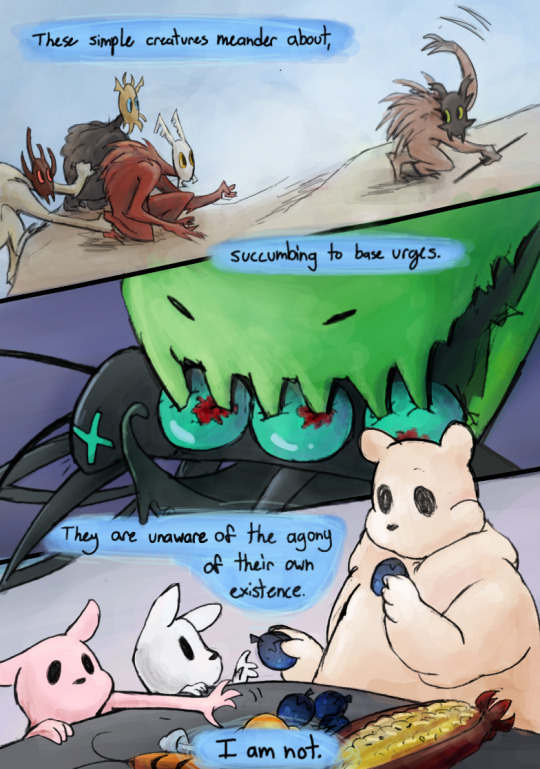

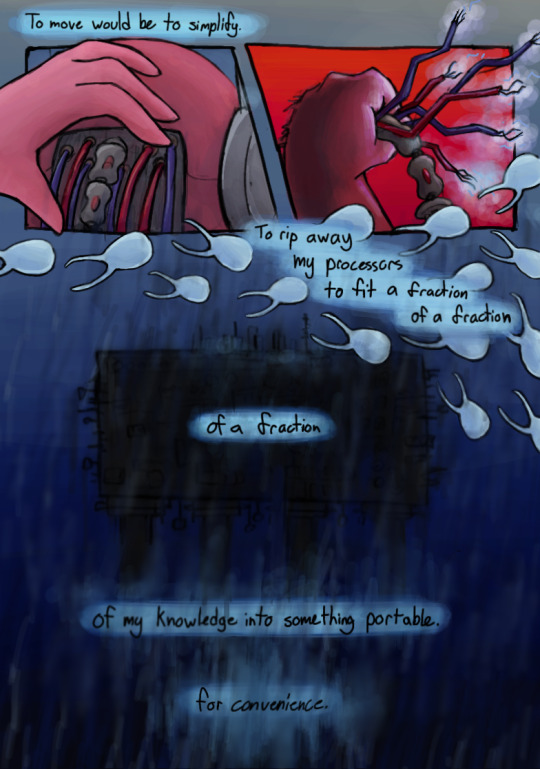

case study of the self-identified god
#obsessed with the fact that rain world is a game about survival#yet every character we meet has the express goal of trying to optimize killing themselves#every creature in game seems perfectly content fulfilling their role in the ecosystem no matter how many cycles they do the same thing#(rly obvious with gourmand's entire route. guy who lives their life to the fullest without the slightest hint of resentment)#it was really only the ancients who thought they were above it and thought of it as something to escape from#5pebbles is so interesting because the only reason hes “”“godlike”“” is because of his vast knowledge. if he was in any slugcats shoes he#would die instantly which is ironically what hes been trying to do this whole time#this comic was kind of exploring the idea of awareness (divinity) as something that drags down ones enjoyment of life (walking).#if 5p would humble himself down enough to walk around like any other creature#he would a) be much happier in life and b) achieve the ascension he's been gunning for for millennia like all the slugcats did#but he never will.#getting rid of all his work on the problem or even his awareness of it entirely#would just be a trick of convenience that steals away his godhood#and him calling himself godlike is kind of a cope LOL#a cope being faced with a problem he was never meant to solve#a cope being faced with what he did to moon#a cope being faced with the rot inside him#oh well.#anyway fuck 5 pebbles i hate that guy#rain world#rain world fanart#rw five pebbles#rain world five pebbles#rw gourmand#rain world gourmand#five pebbles#rain world void worm#rain world ancients#also JUST KIDDING ilu 5p. you suck but i💛u
2K notes
·
View notes
Photo

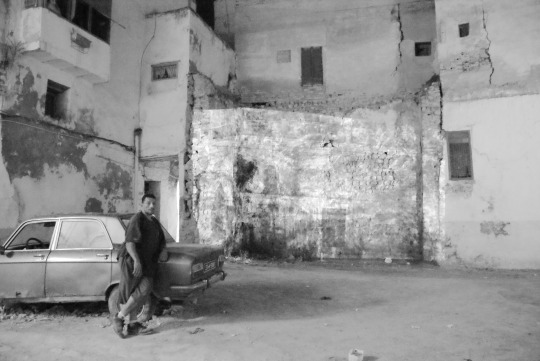

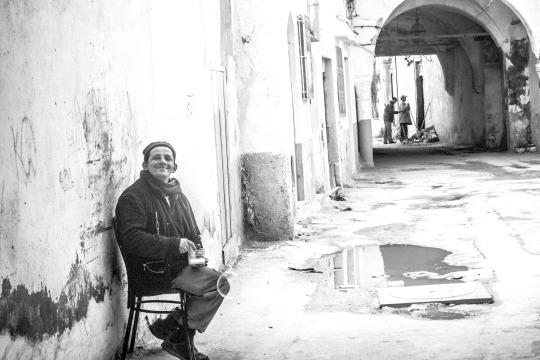
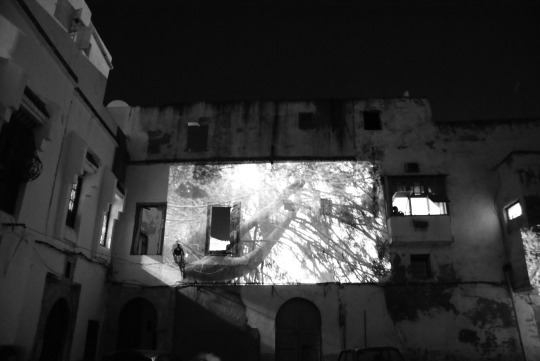

THE LANGUAGE OF WAVES
Three months have passed since Interference, an international light art project in the Medina of Tunis and the first of its kind on the African continent, filled the public space for four days.
Light was switched on, illuminating our neighbourhoods and bringing people together from near and afar.
After switching it off, all material traces vanished, but memories and emotions continue to linger on, reminding us of the unique encounters we were fortunate to experience.
مهرجان متاع الضوء؟
Light art? In the Medina?
People’s first reactions to the concept were mostly surprised and sceptical, “Aren’t bigger and more acute issues at hand, than projecting bubbles on to walls?”; “Why not look at the ground and illuminate the garbage polluting our alleys instead of projecting abstract shapes on to our walls?”, were comments I overheard from passers-by in the Medina.
Fair enough, I understand the scepticism. The idea is far-fetched and might not come to mind when thinking about strategies to promote heritage, intercultural dialogue and arts in the public space for the community. However, give the whole idea some thought and the medium’s relevance in current society begins to surface.
Interference is a vision that allows no obstacles; a vision that art is for all; a vision that money is not the key-factor for the success of your idea; and most of all, a vision that through the help of others we can achieve almost EVERYTHING.
Interference owes its successful execution to the voluntary help of others, help which wasn’t only offered by the more than 150 restless and engaged volunteers, but also by the community of the Medina. From the early days of organising to the festival itself, acts of helpfulness and generosity were omnipresent. You could spot anything from passers-by helping volunteers carry their equipment, compassionate friends and family donating food and drinks, to neighbours allowing the use of their electricity for the testing of artworks or project enthusiasts offering to share their homes with artists and volunteers. These countless gestures of self-devotion to a cause are what gave the festival its sturdy base.
No budget? No problem. Aymen Gharbi and Bettina Pelz, the two masterminds behind the project, were going to prove that money could not get in the way of their vision. The idea attracted and brought together people and artists from different backgrounds and environments, some of them having never heard about Tunisia before except for maybe the negative news that they had heard in the news. Nevertheless, they were convinced by the project and prepared to, at their own cost, join the adventure.
Upon landing in the Medina, everyone soon realised that collaboration and understanding functions beyond languages and cultures.
Meet Tom Groll, one of the two German artists with Kuno Seltmann, responsible for the piece Biocenosis in Nahj al-Maktaa, an artwork defined as, “a mix of photographic footage from the Medina, the artists’ home area and natural phenomena, collaged in a projection environment.” When asked how he selected the specific space for his artwork, he answered:
“The space has a surreal ambiance and feels like a film set. Part of a building is in ruins of which nothing but a facade remains, allowing you to glance through broken windows looking out to a Tunisian flag. I feel like it’s a magical spot where everything is possible, observing the people living in harmony with each other, the cats, sheep and us, the foreigners, in the middle of it all. One of the first times I was checking out Nahj al-Maktaa I heard someone shout loudly and laugh. I took photographs of the site and then of him. Then two of his brothers followed and we started communicating through facial expressions and gestures. While we were testing a projection I started filming them and then projected their images on the walls. It was a blast for them and for me!” And so a beautiful relationship between Tom, Kuno and the three Nahj al-Maktaa brothers began to unfold.
Everyone who visited the festival would agree, that while the whole Medina was buzzing with visitors, this site on Nahj al-Maktaa managed to keep its calm and peaceful energy, at times taking on a meditative character.
Imagine a vast and open space surrounded by buildings and facades in ruins, reflecting images of swaying trees, underwater organisms, which deceive your senses, draw you in and make you feel like you and the wall are one.
Hypnotized and enchanted, sits Makrem, one of the three brothers, facing the artwork, falling under its spell until he’s torn out of it by the realization that the image has morphed in to an image of himself. The installation, Biocenosis, mixes here and there, us and them, making it impossible for us to distinguish; who are we and who are they? Is it even important to distinguish this? This piece of work brought people together from different types of upbringing and environments, speaking completely different languages yet still managing to communicate with each other.
Meet Makrem, Mehrez and Flen, three brothers and almost prominent young men in the neighbourhood around Nahj al-Bacha.
Makrem can be spotted from as early as 5am in the morning spreading Bkhour (incense) around the Medina and instantaneously spreading smiles and happiness through his positive energy. His two brothers can be heard shouting, mostly when they exclaim discontent at the amount of cars and traffic jams in the Medina, frantically trying to bring order to the crowded alleys. Otherwise, the brothers are all masters at keeping themselves busy, clearing the streets of branches and litter or hitching a ride with a scooter passing by. They’re never bored or sitting around killing time. There’s always something to do, something to move, someone to greet.
With Tom and Kuno arrived their new calling, which was to make sure that all of the artists’ needs were met. If the lamps weren’t turned off in time for a light rehearsal at night, Mahrez would make sure he could find some blankets to cover them. Early some mornings, the Maktaa brothers would pass by the house where Tom and Kuno were staying, to check on the artists to see if they could be of any use or to simply spread incense in their home. For the duration of the artists’ stay, they were absolutely restless in their attempt to help.
Meet Kuno Seltmann, the second driving force behind Biocenosis. When asked about his fondest memory of his time in the Medina, he replied, “I was sitting on the ground in Nahj
al-Maktaa one night, waiting to record the first prayer of the muezzin. A few minutes after the call to prayer had started, one of the Maktaa brothers (the strong one, who’s name we never heard) came out of his house, ready to begin the day. I was touched so deeply because every night he had been spending with us on the Biocenosis site, watching us, always doing something, helping us and helping others until midnight. He gave us so much of his energy by being there, by relentlessly helping us; and all that after an unimaginably long day of hard work, collecting and carrying things around the Medina. He is such a strong person and has a great heart. After he recognised me, sitting there at the very beginning of the day, he smiled and insisted on helping me back to my apartment.”
The risk of bringing someone (in this case, artists) to a foreign place, is that they could bring along pre-existing ideas and concepts, which might be completely out of context with the new space they currently find themselves in, possibly forcing them on an environment which might not necessarily agree with and accept them. Interference, however, proved the exact opposite thanks to the sensitivity of the artists and the welcome they found among the Medina residents.
In physics, the term interference is defined as, “a phenomenon in which two waves superpose to form a resultant wave of greater, lower, or the same amplitude.” Interference took over this definition and made it a social phenomenon.
In this case, the waves represent the Medina and light art; the local community and foreign artists; UNESCO world heritage and a contemporary art form; waves completely different from each other but neither one of them considering themselves to be higher or lower; waves which manage to meet and communicate at eye level, respecting and embracing differences and similarities.
In Tom’s opinion, the positive result and impact of the festival owed their success to powerful resonance, triggered by impulses of passion and optimism. This resonance managed to move many people and awaken their appreciation for an art form, which was previously unknown to them. Thanks to the high level of community involvement, participants were able to understand, study and become part of the movement and art, as opposed to only being consumers or observers. Tom explains this visibly by describing a stone being thrown in to the water, the stone symbolising an impulse and the ripples the expanding resonance.
Tom describes the festival community as a driving force, “Finding myself in a foreign country, I still felt completely at home. I was welcomed on the spot and reminded of this hospitality every day through the smiles, hugs and kisses I was receiving everywhere I went. This warmth charged me with so much energy.” He considers himself lucky, not only to have been able to contribute to the festival, but also to have been able to discover and experience Tunis first hand, being catapulted directly in to the middle of the community, living and sharing everything with them. “Now being back home in Germany, it’s impossible for me to explain my experiences to my friends.…So much happened on an emotional level and was so deeply touching. I’m sure this goes for all of the other German artists.…it was a magical experience filled with magical encounters. It might not have been our primary goal as artists to achieve something spiritually moving, but it ended up being the case. The title of our piece Biocenosis came to life, thanks to our site, the presence of the three Maktaa brothers as well as us the artists. This took our piece to another level and gave it a human character with emotions and its own energy.”
Now when I walk on Nahj al-Bacha I am often asked, “Hey, where did the light people go? Will they come back next week? Where’s that guy with the ripped pants? (referring to Kuno) I miss him!”
Interference was an encounter of many waves, that met and learned from each other, each set of voices adding and taking knowledge. It proved that art is a universal language that can break barriers and prejudices and bring people together to confront, embrace and learn to love each other’s differences and voices. Kuno added, “I think meaningful exchange works in a very personal way. All of the deep connections I had with people in Tunis really opened my mind to many subjects that I haven´t thought about before. I came to the realisation that somehow, no matter where we come from, we’re all affected by similar things in life. There are so many meeting points! It opened my mind to talk to all the people about their great thoughts, ideas and ways of seeing reality. The experience of meeting people who are riding the same wave, really touched me and it is this which still connects me with my Tunisian friends! New ideas can grow from this connection.”
We all await the next wave of Interference!
Text: Emily Sarsam
Special thanks to: Tom Groll, Kuno Seltmann, Elizabeth Dobie-Sarsam
Image 1: Sabina von Kessel - Tom and Kuno at the site of BIOCENOSIS
Image 2: Emily Sarsam - Mehrez at the site of the artwork on Nahj al Maktaa
Image 3: Emily Sarsam - Makrem at the site of the artwork on Nahj al Maktaa
Image 4: Emily Sarsam - A preview of BIOCENOSIS on Nahj al Maktaa
Image 5: Mehdy Khmili - The team of INTERFERENCE
#interference#the medina of tunis#tunis#light art#art in the public space#intercultural dialogue#tom groll#kuno seltmann#journal de la medina
0 notes